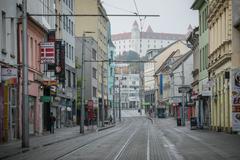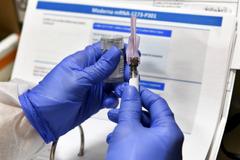Following the dramatically worsening situation with the increasing surge of new daily cases and the increase in deaths, the pandemic commission has proposed that Slovakia applies a curfew again.

The rules would be similar to those imposed after the pilot mass testing in Orava. This means that it would be possible to go to the nearest grocery shop and chemist, as well as to work or school, walk pets and go to the countryside within the district one lives in.
The commission suggests the lockdown should last until January 10, 2021.
This is still only a proposal and it needs to be approved by the cabinet.
Health Minister Marek Krajčí (OĽaNO) stressed that it is necessary to impose the lockdown as soon as possible.
“The more it is delayed, the later we’ll achieve the more positive numbers necessary for lifting the restrictions,” he told journalists on December 11.
Chief epidemiologist Henrieta Hudečková stressed that it is essential to reduce mobility, and thus mutual contacts. The length of lockdown will depend on when it is imposed.
“If we don’t do anything, we’ll face a very bad situation,” Hudečková said.
The situation has deteriorated
The epidemiological situation in Slovakia has deteriorated significantly in the past few days and the spread of the disease is no longer under control, Krajčí admitted.

The tempo of the seven-day increase in new daily cases rose by 32 percent compared to last week. The reproductive number has grown, too, to 1.35 between December 3 and 7.
The share of positive PCR tests of the total number of tests currently stands at 18.8 percent. On the other hand, the number of tests has increased as there are also more antigen tests being carried out at the mobile testing sites. The number of these sites is expected to increase, too, Krajčí said.
At the same time, the number of hospitalised patients infected with COVID-19 is increasing, with hospitals reporting 300 new coronavirus patients during the past week. Currently, there are about 2,000 patients with either confirmed or suspected coronavirus disease. Moreover, more than 2,900 healthcare staff have tested positive for the virus.
The number of deaths is increasing, too. Every fifth hospitalised patient dies of the coronavirus, Krajčí said. Many of them get infected directly in hospitals, while there are also hot spots in the nursing homes, he added.
The situation is worsening across the regions. The worst situation is in the Trenčín Region, but it is gradually deteriorating also in the Trnava and Bratislava Regions. The hardest-hit districts are Trenčín, Považská Bystrica, Púchov, Nitra, Skalica and Ilava.

Plan for vaccination
The pandemic commission has also agreed on the plan for vaccination.
There should be four waves:
first: healthcare staff, employees of nursing homes, critical infrastructure;
second: people older than 65 years, people suffering from chronic diseases, clients of nursing homes;
third: marginalised groups, homeless people, asylum seekers, teachers;
four: everybody older than 18 years (voluntary principle)



 The emptied streets of Bratislava in late October when the curfew was applied. (source: TASR)
The emptied streets of Bratislava in late October when the curfew was applied. (source: TASR)